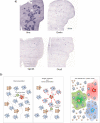Positive and negative selection of the T cell repertoire: what thymocytes see (and don't see)
- PMID: 24830344
- PMCID: PMC4757912
- DOI: 10.1038/nri3667
Positive and negative selection of the T cell repertoire: what thymocytes see (and don't see)
Abstract
The fate of developing T cells is specified by the interaction of their antigen receptors with self-peptide-MHC complexes that are displayed by thymic antigen-presenting cells (APCs). Various subsets of thymic APCs are strategically positioned in particular thymic microenvironments and they coordinate the selection of a functional and self-tolerant T cell repertoire. In this Review, we discuss the different strategies that these APCs use to sample and process self antigens and to thereby generate partly unique, 'idiosyncratic' peptide-MHC ligandomes. We discuss how the particular composition of the peptide-MHC ligandomes that are presented by specific APC subsets not only shapes the T cell repertoire in the thymus but may also indelibly imprint the behaviour of mature T cells in the periphery.
Figures




Comment in
-
Neonatal immunity: babies' T cells can fight.Nat Rev Immunol. 2014 Nov;14(11):714-5. doi: 10.1038/nri3758. Epub 2014 Oct 10. Nat Rev Immunol. 2014. PMID: 25301253 No abstract available.
References
-
- Kyewski B, Klein L. A central role for central tolerance. Annual review of immunology. 2006;24:571–606. - PubMed
-
- Klein L, Hinterberger M, Wirnsberger G, Kyewski B. Antigen presentation in the thymus for positive selection and central tolerance induction. Nature reviews. Immunology. 2009;9:833–844. - PubMed
-
- Murata S, Sasaki K, Kishimoto T, Niwa S, Hayashi H, et al. Regulation of CD8+ T cell development by thymus-specific proteasomes. Science. 2007;316:1349–1353. - PubMed
Publication types
MeSH terms
Substances
Grants and funding
LinkOut - more resources
Full Text Sources
Other Literature Sources
Research Materials
Miscellaneous

